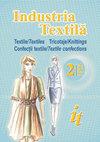1-十四胺、N,N-二甲基-N-[3-(三甲氧基硅基)丙基]氯化物处理针织间隔织物的抗菌性能研究
IF 0.9
4区 工程技术
Q3 MATERIALS SCIENCE, TEXTILES
引用次数: 0
摘要
目前的研究有助于了解抗菌处理对湿编间隔织物的功效。本研究使用的抗菌剂来自季铵盐类。织物的抗菌功效进行了评估。并将其抗菌和抗生物膜活性与市场上现有的药物和一些高级伤口敷料进行了交叉比较。用1-十四胺,N,N-二甲基-N-[3-(三甲氧基硅基)丙基]氯化物(QAS)处理的针织间隔织物具有良好的抗菌性能,并且对革兰氏阳性细菌,革兰氏阴性细菌以及真菌和酵母具有广泛的抗菌作用。杀灭的速度和微生物活性的持久性使其成为非常适合用于伤口护理材料等感染控制的材料。这种隔离织物在处理伤口渗出物时可以起到泡沫的作用。当涉及到微生物污染的管理,包括生物膜的预防和破坏时,与其他敷料材料相比,这种材料的功效产生了大量的证据,证明了它作为伤口敷料材料的活性。这种材料可用于慢性伤口的治疗,是有临床证据的进一步研究的主题。本文章由计算机程序翻译,如有差异,请以英文原文为准。
Study of antimicrobial property of knitted spacer fabric treated with 1-Tetradecanaminium, N,N-dimethyl-N-[3-(trimethoxysilyl)propyl], chloride
The current study helps to understand the efficacy of antimicrobial treatment done on a weft-knitted spacer fabric. The antimicrobial agent used in the study is from the class of quaternary ammonium salts. The fabric is evaluated for antimicrobial efficacy. It is also cross-compared with the drug and some advanced wound dressings available in the market for its antimicrobial and anti-biofilm activity. Knitted spacer fabric treated with 1-Tetradecanaminium, N,N-dimethyl-N-[3-(trimethoxysilyl)propyl], chloride (QAS) shows good antimicrobial properties and is shown to exhibit a broad range of antimicrobial effects against gram-positive bacteria, gram-negative bacteria and also fungus and yeast. The rapidity of killing and durability of microbial activity make it a very suitable material for infection control in applications like wound care materials. The spacer fabric can behave as foam in the management of exudates in wounds. The efficacy of this material compared with other dressing materials yields substantial evidence of its activity as a wound dressing material when it comes to management of microbial contaminations including biofilm prevention and disruption. Such material can find use in the management of chronic wounds and is a subject matter of further studies with clinical evidence.
求助全文
通过发布文献求助,成功后即可免费获取论文全文。
去求助
来源期刊

Industria Textila
工程技术-材料科学:纺织
CiteScore
1.80
自引率
14.30%
发文量
81
审稿时长
3.5 months
期刊介绍:
Industria Textila journal is addressed to university and research specialists, to companies active in the textiles and clothing sector and to the related sectors users of textile products with a technical purpose.
 求助内容:
求助内容: 应助结果提醒方式:
应助结果提醒方式:


